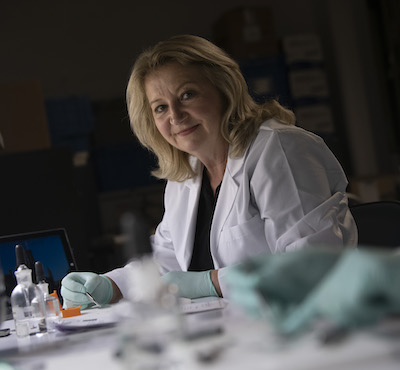The pilot reported that his plane had hit something in the air big enough to knock a hole in the side of the wing. But when Carla Dove, MS Biology ’94, PhD Environmental Science and Public Policy ’98, received the strike sample's DNA results from the lab, she was stumped. “It kept coming back as whitetail deer…we sent it three times.”

The case of the deer in the sky was just one of the 10,000 bird strike cases Dove’s team investigates every year in the Feather Identification Lab at the Smithsonian’s National Museum of Natural History. As program manager, the George Mason University alum identifies the specific birds involved in collisions, with samples coming to her from various branches of the U.S. military, commercial airlines, and more.
It's work that can save lives and improve flight safety. Once the species is identified, airfield biologists work to mitigate the habitat to keep those birds from being attracted to the airfield, while engineers use the data to design safer aircraft and build models to increase awareness of this aviation hazard.
Dove has done this work for decades, going back to when she was pursuing her master’s and PhD at Mason. Mason’s flexibility, she said, was ideal. “The courses being offered at night allowed me to work during the day.”
She also credits the mentorship she received from the late Mason professor emeritus Carl Ernst. “He was extremely helpful, patient, and encouraging because he knew I was a first-generation college student and that I needed a little bit of extra help.”

Dove’s experience is typical of Mason’s ethos of welcoming and supporting every kind of student, with 40% of current students identifying as first-generation.
Because of Dove’s work with government and military entities, Ernst advised her to look at a policy PhD. Dove says her PhD helped her advance professionally. “It helps open doors; it helps write grants. It was something that I needed for my job here.”
And her job is a busy one. In addition to the aviation industry, Dove works on everything from crime scene investigations (think evidence from a down jacket or a pillow) to identifying the feathers used on anthropological artifacts like arrow heads, spear tips, and headdresses.
As for that collision supposedly caused by a deer at 1,500 feet? Dove took another look and found a tiny feather remnant. When she observed it under the microscope, it all clicked into place.
“It turned out to be a black vulture,” she said. The bird was likely feeding on a deer just before it soared into the sky and collided with the plane. “That for me was a case of ‘mind over molecules’…you always have to have an open mind [and] think about it in the broad sense—how does all this fit?”
It all comes down to being able to think differently—just one of the ways Dove and her alma mater are birds of a feather.
Recent News
- November 11, 2025
- October 15, 2025
- April 4, 2025
- January 23, 2025
- March 8, 2024
